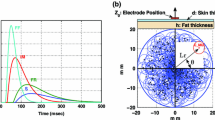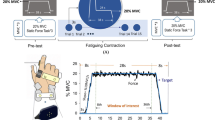Abstract
The sensitivity of the electromyogram (EMG)–force relation to changes in motoneuron and muscle properties was explored using a simulation approach, and by applying existing motoneuron pool, muscle force, and surface EMG models. The simulation results indicate that several factors contribute potently to known changes in the EMG–force relation in paretic stroke muscles. First, compression of the motor unit recruitment range with respect to the injected current tends to generate greater EMG amplitude at a given force, and to produce a highly nonlinear EMG–force relation. The overall mean slope of the EMG–force relation tends to be flatter, primarily because of this non-linear behavior. Second, with reductions of the mean motor unit firing rates, the slope of the EMG–force relation also tends to increase especially as the mean firing rates dropped substantially below the motor unit fusion frequency. Finally, similar effects were observed with a reduction in the number of motor units, and with variation in motor unit contractile properties, which also altered the EMG–force relation. These findings provide new insight toward our understanding of experimental EMG–force relations in both normal and pathological states, such as the abnormal EMG–force relations of paretis muscles in stroke.





Similar content being viewed by others
References
Andreassen, S. Rosenfalck, A. (1980) Regulation of the firing pattern of single motor units. J. Neurol. Neurosurg. Psychiatr. 43: 897–906
Basmajian, J. V., DeLuca, C. J. (1985) Muscles Alive: Their Functions Revealed by Electromyography. Williams & Wilkins, Baltimore
Blaschak, M. J., Powers, P. K., Rymer, W. Z. (1988) Disturbance of motor outputs in a cat hindlimb muscle after acute dorsal spinal hemisection. Exp. Brain Res. 71: 377–387
Datta, A. K., Stephens, J. A. (1990) Synchronization of motor unit activity during voluntary contraction in man. J. Physiol. 422: 397–419
De Luca, C. J., Foley, P. J., Erim Z. (1996) Motor unit control properties in constant-force isometric contractions. J. Neurophysiol. 76: 1503–1516
Erim, Z., De Luca, C. J., Mineo, K., Aoki, T. (1996) Rank-ordered regulation of motor units. Muscle Nerve 19: 563–573
Farina, D., Fortunato, E., Merletti, R. (2000) Noninvasive estimation of motor unit conduction velocity distribution using linear electrode arrays. IEEE Trans. Biomed. Eng. 47: 380–388
Feinstein, B., Lindegard, B., Nyman, E., Wohlfart, G. (1955) Morphologic studies of motor units in normal human muscles. Acta Anat. (Basel) 23: 127–142
Fuglevand, A. J., Winter, D. A., Patla, A. E. (1993) Models of recruitment and rate coding organization in motor-unit pools. J. Neurophysiol. 70: 2470–2488
Gemperline, J. J., Allen, S., Walk, D., Rymer, W. Z. (1995) Characteristics of motor unit discharge in subjects with hemiparesis. Muscle Nerve 18: 1101–1114
Hara, Y., Masakado, Y., Chino, N. (2004) The physiological functional loss of single thenar motor units in the stroke patients: when does it occur? Does it progress? Clin. Neurophysiol. 115: 97–103
Herdmann, J., Budingen, H. J., Reiners, K., Berger, W., Freund, H. J. (1986) Dependence of the action potential amplitude of motor units on the recruitment threshold: implications for electromyography. EEG EMG Z Elektroenzephalogr Elektromyogr Verwandte Geb 17: 140–146
Jones, K. E., Hamilton, A. F., Wolpert, D. M. (2002) Sources of signal-dependent noise during isometric force production. J. Neurophysiol. 88: 1533–1544
Kernell, D. (1965) The adaptation and the relation between discharge frequency and current strength of cat lumbosacral motoneurones stimulated by long-lasting injected currents. Acta Physiol. Scand. 65: 65–73
Lawrence, J. H., De Luca, C. J. (1983) Myoelectric signal versus force relationship in different human muscles. J. Appl. Physiol. 54: 1653–1659
Lo Conte, L. R., Merletti, R., Sandri, G. V. (1994) Hermite expansions of compact support waveforms: applications to myoelectric signals. IEEE Trans. Biomed. Eng. 41: 1147–1159
Mao, J. J., Major, P. W., Osborn, J. W. (1996) Coupling electrical and mechanical outputs of human jaw muscles undertaking multi-directional bite-force tasks. Archs Oral Biol. 41: 1141–1147
Maton, B., Peres, G., Landjerit, B. (1987) Relationships between individual isometric muscle forces, EMG activity and joint torque in monkeys. Eur. J. Appl. Physiol. Occup. Physiol. 56: 487–494
Milner-Brown, H. S., Stein, R. B. (1975) The relation between the surface electromyogram and muscular force. J. Physiol. 246: 549–569
Milner-Brown, H. S., Stein, R. B., Yemm, R. (1973) The orderly recruitment of human motor units during voluntary isometric contractions. J. Physiol. 230: 359–370
Moritani, T., deVries, H. A. (1978) Reexamination of the relationship between the surface integrated electromyogram (IEMG) and force of isometric contraction. Am. J. Phys. Med. 57: 263–277
Moritz, C. T., Barry, B. K., Pascoe, M. A., Enoka, R. M. (2005) Discharge rate variability influences the variation in force fluctuations across the working range of a hand muscle. J. Neurophysiol. 93: 2449–2459
Olmo, G., Laterza, F., Lo Presti, L. (2000) Matched wavelet approach in stretching analysis of electrically evoked surface EMG signal. Signal Process 80: 671–684
Perreault, E. J., Day, S. J., Hulliger, M, Heckman, C. J., Sandercock, T. G. (2003) Summation of forces from multiple motor units in the cat soleus muscle. J Neurophysiol 89: 738–744
Scelsi, R. (2001) Skeletal muscle pathology after spinal cord injury: our 20 year experience and results on skeletal muscle changes in paraplegics, related to functional rehabilitation. Basic Appl. Myol. 11: 75–85
Stein, R. B., French, A. S., Mannard, A., Yemm, R. (1972) New methods for analyzing motor function in man and animals. Brain Res. 40: 187–192
Stevens, A., Stijns, H., Reybrouck, T., Bonte, G., Michels, A., Rosselle, N., Roelandts, P., Krauss, E., Verheyen, G. (1973) A polyelectromyographical study of the arm muscles at gradual isometric loading. Electromyogr. Clin. Nneurophysiol. 13: 465–476
Solomonow, M., Baratta, R., Shoji, H., D’Ambrosia, R. (1990) The EMG–force relationships of skeletal muscle; dependence on contraction rate, and motor units control strategy. Electromyogr. Clin. Neurophysiol. 30: 141–152
Suresh, N. L., Rymer, W. Z., Ellis, M. D. (2005) Impaired spatial control of motor units in hemiparetic stroke. Soc. Neurosci. Abstr. 31: 399.19
Tang, A., Rymer, W. Z. (1981) Abnormal force-EMG relations in paretic limbs of hemiparetic human subjects. J. Neurol. Neurosurg. Psychiatr. 44: 690–698
Taylor, A. M., Christou, E. A., Enoka, R. M. (2003) Multiple features of motor-unit activity influence force fluctuations during isometric contractions. J. Neurophysiol. 90: 1350–1361
Taylor, A. M., Steege, J. W., Enoka, R. M. (2002) Motor-unit synchronization alters spike-triggered average force in simulated contractions. J. Neurophysiol. 88: 265–276
Thomas, C. K., Bigland-Ritchie, B., Johansson, R. S. (1991) Force–frequency relationships of human thenar motor units. J. Neurophysiol. 65: 1509–1516
Woods, J. J., Bigland-Ritchie, B. (1983) Linear and non-linear surface EMG/force relationships in human muscles. An anatomical/functional argument for the existence of both. Am. J. Phys. Med. 62: 287–299
Zhou, P., Rymer, W. Z. (2004a) MUAP number estimates in surface EMG: template matching methods and their performance boundaries. Ann. Biomed. Eng. 32: 1007–1015
Zhou, P., Rymer, W. Z. (2004b) Factors governing the form of the relation between muscle force and the EMG: a simulation study. J. Neurophysiol. 92: 2878–2886
Author information
Authors and Affiliations
Corresponding author
Appendix
Appendix
Motoneuron Pool Model
To assess the impact of different motor unit recruitment and firing rate strategies, we simulated input and output properties of the FDI motoneuron pool. The motoneuron threshold distribution was modeled as an exponential of the form:9
where RTE is recruitment threshold excitation, i is an index identifying the motoneuron, and a is a coefficient used to establish a range of threshold values; ln is the natural logarithm, RR is the range of recruitment thresholds desired, and n is the total number of neurons. By this means, many neurons were assigned low thresholds while relatively few neurons were assigned high thresholds. A motoneuron remained inactive as long as the excitatory drive was less than the neuron’s assigned recruitment threshold value. The firing rate of a motoneuron was modeled to increase linearly with excitatory drive above the recruitment threshold excitation. The slope of the excitatory drive-firing rate relation was set to be the same for all motoneurons.14 Peak firing rates were linked to the mechanical properties of motor units, i.e. large rapidly contracting units were assigned higher peak firing rates than were those with lower force recruitment thresholds and with small twitches and slow contraction times. The minimum firing rate was set at 8 Hz for every motoneuron. The inter-spike interval of the motor unit firing was modeled as a random process with a Gaussian probability distribution function.1 The standard deviation of the inter-spike interval was fixed for all motor units at 15% of the mean inter-spike interval.
Motor Unit and Muscle Force Generation Model
Twitch force was modeled as the impulse response of a critically damped, second order system.26 Similar to motoneuron threshold distribution, twitch amplitude (P) was varied over a wide range and was linked to the motor unit recruitment threshold:
where P is the amplitude of twitch force, i is an index identifying the motor unit, b is a coefficient used to establish a range of twitch force values, ln is the natural logarithm, RP is the range of twitch amplitude desired, and n is the number of motor units. By this means, a large number of units produced small forces while relatively few units generated large forces.
The relation between twitch amplitude (P) and contraction time (T) was approximated as an inverse power function in the form:9
where T L represents the longest contraction time desired for the pool. RP is the range of motor unit twitch amplitude as defined previously. RT is the range of contraction time desired. In this way, a large number of motor units were designated as slow twitch, and relatively few units were set as fast twitch. The force generated by each motor unit was calculated based on the established sigmoidal relation between motor unit force and motor unit firing rate.33 Total force of the muscle was then calculated as the linear summation of all the individual motor unit forces.
Surface EMG Simulation
The surface EMG signal is comprised of the sum of MUAPs from different motor units. In general, the waveform of a MUAP is determined by the relative position of the recording electrode and the muscle fiber distribution within the motor unit. For different motor units, the muscle fiber distributions within the muscle are potentially different. However, for surface EMG recordings, the detection surface is large and relatively distant from the motor unit current sources. Consequently, differences in detailed muscle fiber arrangements of motor units are less important. In addition, because of the low-pass filter effects of skin and subcutaneous tissues, and the spatial integrating effects provided by the surface electrode, the differences in the shapes of surface MUAPs from different motor units will be further obscured. It follows that the waveforms of the surface MUAPs are routinely much less complex than those recorded using intramuscular electrodes.
The Hermite–Rodriguez (HR) functions were selected to represent surface MUAPs as described by earlier investigators.7,16,23 The nth order HR function is proportional to the nth derivative of a normal function. Its expression is:
Accordingly, the expression of the first order HR function (HR1) is:
where, k is normalization factor.
We have shown earlier35 using the spike triggered averaging technique, that the basic shapes of the recorded MUAPs can be well represented by the HR1 function. Accordingly, in the simulation, the HR1 function was routinely used to represent the basic shape of surface MUAPs. Due to the wide distribution of the motor unit muscle fibers throughout the FDI muscle, all the motor units may be viewed as being at similar depth, which results in similar duration of the recorded surface MUAPs.19 Therefore, in our surface EMG simulation, the MUAPs from different motor units were assigned the same duration (∼12 ms) based on the experimental observations for the FDI muscles.35 MUAP peak-to-peak amplitude was linearly proportional to twitch force. This choice was made because the linear relations are supported both by theoretical and experimental observations.12
Rights and permissions
About this article
Cite this article
Zhou, P., Suresh, N. & Rymer, W. Model Based Sensitivity Analysis of EMG–Force Relation with Respect to Motor Unit Properties: Applications to Muscle Paresis in Stroke. Ann Biomed Eng 35, 1521–1531 (2007). https://doi.org/10.1007/s10439-007-9329-3
Received:
Accepted:
Published:
Issue Date:
DOI: https://doi.org/10.1007/s10439-007-9329-3




